Introduction
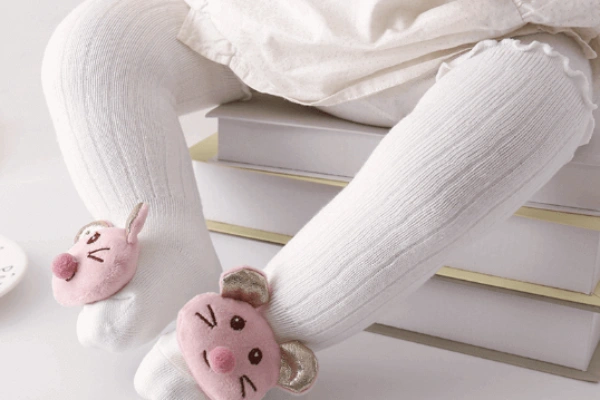
Choosing the right fabric for baby socks is essential for ensuring comfort, safety, and overall skin health. Babies have sensitive skin that requires special attention, especially in clothing items like socks, which are in constant contact with their feet. While cotton has long been the go-to material for baby socks, new alternatives like bamboo and organic fabrics are making waves due to their softness, eco-friendliness, and hypoallergenic properties. In this article, we’ll explore the pros and cons of the most popular fabrics for baby socks, provide tips for keeping socks in good condition, and discuss how to choose the best socks for babies with sensitive skin.
The Importance of Choosing the Right Fabric for Baby Socks
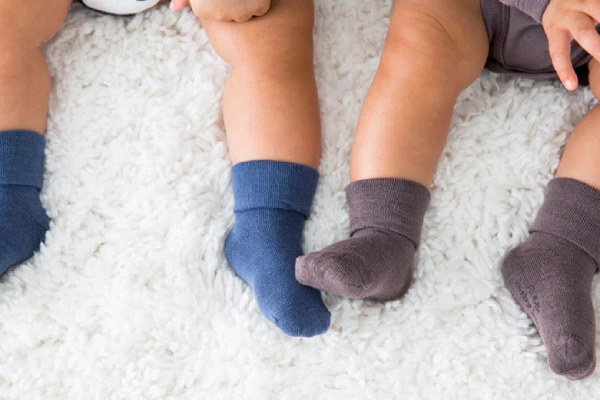
When it comes to baby socks, comfort and skin health should be at the forefront of fabric choice. Babies’ feet are soft, delicate, and sensitive, so the fabric of their socks must meet certain criteria:
- Breathability: A good fabric will allow air to flow through, keeping feet dry and comfortable.
- Softness: Fabrics must be gentle to avoid irritation, especially for babies with sensitive skin or conditions like eczema.
- Durability: Baby socks go through frequent washes, so the fabric should be able to withstand wear and tear without losing its form.
Choosing the right fabric not only ensures comfort but also helps in promoting overall health by reducing the risk of rashes, infections, and discomfort. Keep in mind that different fabrics have different qualities, and selecting the best fabric for your baby’s specific needs is key to achieving the perfect fit and feel.
Cotton: A Classic Favorite
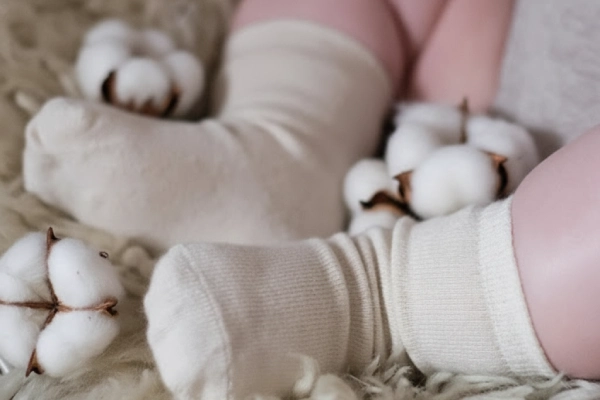
Cotton is by far one of the most commonly used fabrics for baby socks, and for good reason. It’s known for its softness and breathability, making it a comfortable choice for babies.
Pros of Cotton for Baby Socks:
- Softness: Cotton is naturally soft, which makes it gentle on delicate baby skin. This is particularly important for newborns who are sensitive to rough textures.
- Breathability: Cotton allows air to circulate around the feet, preventing the build-up of moisture and keeping feet dry. This breathability makes it ideal for warmer climates or everyday use.
- Hypoallergenic: Cotton is less likely to irritate the skin compared to synthetic materials, making it an excellent choice for babies with eczema or other skin sensitivities.
Cons of Cotton for Baby Socks:
- Durability: While cotton is soft, it tends to wear out faster than synthetic fabrics. Over time, cotton socks may stretch, shrink, or lose their shape.
- Not Very Insulating: Cotton socks are not ideal for colder weather as they don’t provide as much warmth as wool or fleece fabrics.
- Shrinkage: Cotton tends to shrink when washed in hot water or dried on high heat, so it requires special care to maintain its size.
Care Tips for Cotton Baby Socks:
- Wash cotton socks in cold water to prevent shrinking.
- Avoid using fabric softeners, as they can affect the softness and absorbency of the fabric.
- Air-dry cotton socks to maintain their shape and prevent further shrinkage.
For more tips on the best sock options for toddlers, check out: Best Grip Socks for Toddlers: Comfortable and Safe Options.
Bamboo: The Eco-Friendly Alternative
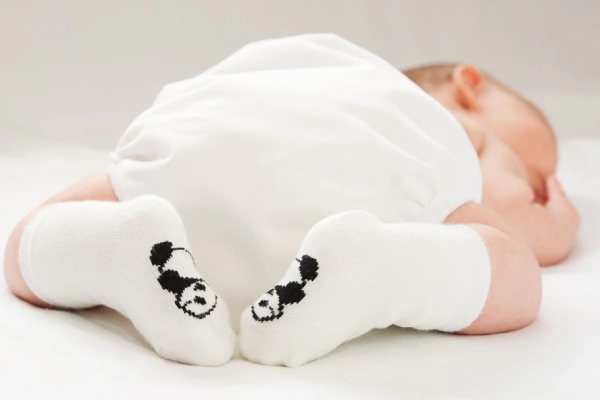
Bamboo fabric has grown in popularity in recent years due to its many benefits for both babies and the environment. Bamboo fibers are naturally biodegradable and can be made into a super-soft, silky fabric ideal for baby socks.
Pros of Bamboo for Baby Socks:
- Antibacterial and Hypoallergenic: Bamboo naturally resists bacteria and fungi, making it an excellent choice for babies with sensitive skin. This feature also helps keep socks fresher for longer.
- Moisture-Wicking: Bamboo fabric excels at moisture absorption and evaporation, making it perfect for babies who tend to sweat. It keeps feet dry and helps prevent the buildup of odor.
- Eco-Friendly: Bamboo is a highly renewable resource. It grows quickly, requires little water, and doesn’t need pesticides, making it a sustainable fabric choice.
- Soft and Gentle: Bamboo fabric is incredibly soft, often described as feeling like silk, making it a comfortable choice for babies’ delicate skin.
Cons of Bamboo for Baby Socks:
- Price: Bamboo socks tend to be more expensive than cotton due to the processing required to turn bamboo into fabric.
- Durability: While soft, bamboo is a more delicate fabric than cotton or synthetic alternatives, meaning it may wear out faster with frequent washing.
- Chemical Processing: Bamboo fabric is typically made using a chemical process to turn bamboo pulp into fiber. While some manufacturers use eco-friendly methods, others may rely on chemicals that can be harmful to the environment.
Care Tips for Bamboo Baby Socks:
- Wash bamboo socks in cold water on a gentle cycle to preserve their softness and integrity.
- Avoid bleach or harsh chemicals, as these can damage the fabric and reduce its moisture-wicking abilities.
- Air-dry bamboo socks to prevent shrinkage and maintain the fabric’s silky feel.
Bamboo is a great choice for eco-conscious parents. If you’re looking for more sustainable options, bamboo socks can be a wonderful alternative to traditional cotton. Explore more sustainable material options in our guide to baby socks in daycare: Baby Socks in Daycare: How Infant Socks Improve Safety, Comfort, and Business Opportunities.
Other Fabrics for Baby Socks: Wool, Organic Fabrics, and Beyond
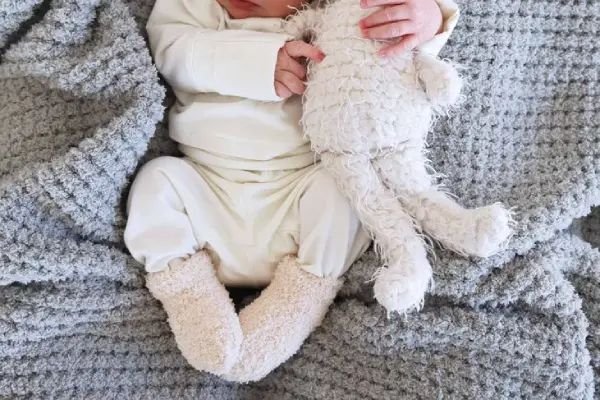
While cotton and bamboo are among the most popular options, there are other fabrics worth considering depending on your baby’s needs and the season.
- Wool: Wool, particularly merino wool, is known for its warmth and moisture-wicking properties. It’s ideal for colder months because it traps heat and keeps feet warm without causing overheating. Wool also has antibacterial properties that help keep feet fresh and dry. However, wool socks may cause irritation for some babies, so it’s best to choose softer, high-quality merino wool for sensitive skin. Wool also tends to be more expensive and requires careful care to prevent shrinking and felting.
- Organic Fabrics: Organic cotton, hemp, and other eco-friendly fabrics are increasingly popular for parents looking for chemical-free, sustainable options. Organic cotton socks are grown without pesticides or synthetic fertilizers, making them a better option for babies with allergies or skin conditions. However, these fabrics can be more expensive than conventional cotton or synthetics, and they may not be as durable over time.
- Synthetic Fabrics (Polyester and Nylon Blends): These materials are durable, moisture-wicking, and affordable. Polyester and nylon blends often have added spandex or elastane to give socks the necessary stretch and elasticity. While these fabrics are more durable and cost-effective than natural fibers, they don’t breathe as well and may cause irritation in some babies. They also tend to trap moisture, which could lead to discomfort or fungal growth on the feet.
Care Tips for Wool and Organic Socks:
- Wool socks should be hand-washed or machine-washed on a delicate cycle with cold water to prevent shrinking.
- Organic cotton socks should be treated the same as regular cotton, but be sure to use mild detergents and avoid harsh chemicals.
- Synthetic socks should be washed in cool water and air-dried to maintain elasticity.
Hypoallergenic and Sensitive Skin Options for Baby Socks
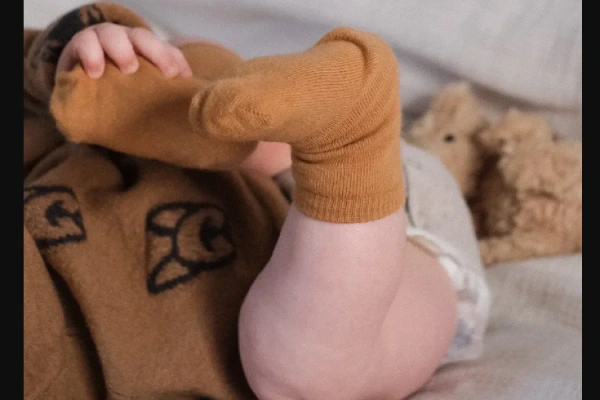
For babies with skin conditions such as eczema or those prone to rashes, choosing hypoallergenic socks is crucial. Sensitive skin needs fabric that is free from harmful chemicals and harsh materials. Hypoallergenic baby socks are made from natural, chemical-free fibers that are less likely to irritate.
Best Fabric Options for Hypoallergenic Baby Socks:
- Organic Cotton: Grown without pesticides, organic cotton is gentle on delicate skin and is less likely to cause allergic reactions.
- Bamboo: Naturally hypoallergenic and antibacterial, bamboo fabric is an excellent choice for babies with skin sensitivities.
- Merino Wool: This type of wool is incredibly soft and less likely to cause irritation than regular wool, making it a good option for babies with mild skin sensitivities. It’s also breathable and helps regulate body temperature, preventing overheating.
Fabric to Avoid: Synthetic fabrics like polyester and acrylic may not be suitable for babies with sensitive skin, as they are less breathable and can trap moisture, which may lead to rashes or discomfort. Stick to natural, hypoallergenic fibers whenever possible.
Care Tips for Sensitive Skin Socks:
- Always wash hypoallergenic socks separately with mild detergent and avoid fabric softeners.
- Ensure socks are thoroughly rinsed to remove any detergent residue that could cause irritation.
- Test new socks on a small area of the skin to ensure there is no allergic reaction.
How to Care for Baby Socks to Extend Longevity and Softness
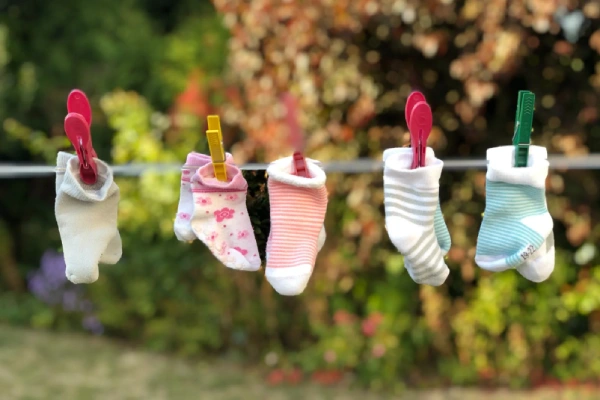
Proper care is essential to extend the life of baby socks, especially when dealing with delicate fabrics like cotton, bamboo, and wool. Here are some general care tips:
- Washing: Always wash baby socks in cold water to prevent shrinking, especially for cotton and bamboo. Use a gentle cycle to avoid damaging the fabric, and be sure to rinse thoroughly to remove any detergent residue.
- Drying: Air drying is the best method for preserving the shape and softness of baby socks. Avoid high heat from the dryer, as this can cause fabrics like cotton and bamboo to shrink or lose their elasticity. Wool socks should be laid flat to dry to avoid deformation.
- Fabric-Specific Care: Follow the specific care instructions for wool, organic cotton, and synthetic blends to ensure they remain in good condition. Wool socks, for instance, should be hand-washed or machine-washed in a wool-specific cycle to prevent felting.
Taking good care of baby socks ensures they last longer, maintaining their softness, elasticity, and comfort.
FAQs
What is the purpose of baby socks?
Baby socks serve several purposes: they keep babies’ feet warm, protect them from abrasions, and help regulate body temperature. Additionally, they prevent cold air from reaching tiny feet and can act as a barrier between feet and shoes, keeping feet dry and comfortable.
Are baby socks a total scam?
Baby socks are not a scam. They are designed to provide comfort, warmth, and protection to delicate feet. However, the effectiveness of baby socks depends on the quality of the fabric, fit, and design. It’s important to choose well-made socks that stay on and don’t irritate.
Newborn socks that actually fit and stay on?
Look for newborn socks with a snug, soft cuff that won’t dig into the skin. Organic cotton, bamboo, or stretchy blends are great options. To keep socks on, choose styles with ribbed tops or elastic bands for a secure fit without being too tight.
What kind of baby socks don’t fall off? Also, grips for walking soon?
For socks that stay on, opt for designs with ribbed cuffs, elastic bands, or sock-ons that secure the socks to the baby’s foot. For toddlers walking soon, choose socks with non-slip grips on the soles to help with traction and stability.
What’s up with the Boomer generation’s obsession with babies and socks?
The Boomer generation’s obsession with babies wearing socks likely stems from traditional care practices, where socks were seen as necessary for warmth and comfort. Socks have also been a popular gift for babies due to their practicality and cuteness.
Conclusion

Choosing the right fabric for baby socks is essential for your baby’s comfort, safety, and overall skin health. Cotton, bamboo, wool, and other materials each have their benefits, but it’s important to select the fabric that suits your baby’s needs and lifestyle. Whether you prefer the softness and breathability of cotton, the eco-friendliness of bamboo, or the warmth and moisture-wicking properties of wool, each fabric offers unique advantages. By following proper care tips, you can extend the life of these essential baby items while keeping your little one’s feet comfortable and protected.
For more insights into baby socks and their benefits, be sure to check out our article on Global Infant Socks Market 2025 Trends & Opportunities.
